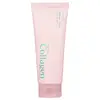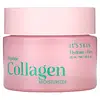What's inside
What's inside
 Key Ingredients
Key Ingredients

 Benefits
Benefits

 Concerns
Concerns

 Ingredients Side-by-side
Ingredients Side-by-side

Water
Skin ConditioningPEG-8
HumectantGlycerin
HumectantMyristic Acid
CleansingPalmitic Acid
EmollientPotassium Hydroxide
BufferingStearic Acid
CleansingLauric Acid
CleansingPEG-32
HumectantSodium Methyl Cocoyl Taurate
CleansingPEG-100 Stearate
Glyceryl Stearate
EmollientPolyquaternium-7
Dipropylene Glycol
HumectantSorbitan Olivate
EmulsifyingButylene Glycol
HumectantSodium Benzoate
MaskingPyrus Communis Fruit Extract
Skin Conditioning1,2-Hexanediol
Skin ConditioningRosa Damascena Flower Water
MaskingCollagen Extract
Skin ConditioningDisodium EDTA
Iris Florentina Root Extract
MaskingJuniperus Mexicana Oil
MaskingCucumis Melo Fruit Extract
Skin ConditioningHedera Helix Leaf/Stem Extract
AntimicrobialRosa Damascena Flower Oil
MaskingBHT
AntioxidantPogostemon Cablin Leaf Oil
MaskingAvena Sativa Peptide
Skin ConditioningVetiveria Zizanoides Root Oil
MaskingWater, PEG-8, Glycerin, Myristic Acid, Palmitic Acid, Potassium Hydroxide, Stearic Acid, Lauric Acid, PEG-32, Sodium Methyl Cocoyl Taurate, PEG-100 Stearate, Glyceryl Stearate, Polyquaternium-7, Dipropylene Glycol, Sorbitan Olivate, Butylene Glycol, Sodium Benzoate, Pyrus Communis Fruit Extract, 1,2-Hexanediol, Rosa Damascena Flower Water, Collagen Extract, Disodium EDTA, Iris Florentina Root Extract, Juniperus Mexicana Oil, Cucumis Melo Fruit Extract, Hedera Helix Leaf/Stem Extract, Rosa Damascena Flower Oil, BHT, Pogostemon Cablin Leaf Oil, Avena Sativa Peptide, Vetiveria Zizanoides Root Oil
Water
Skin ConditioningOctyldodecanol
EmollientHydrogenated Polyisobutene
EmollientButylene Glycol
HumectantGlycereth-26
HumectantGlycerin
HumectantPEG-20 Methyl Glucose Sesquistearate
EmulsifyingStearyl Alcohol
EmollientCetearyl Alcohol
EmollientSodium Polyacrylate
AbsorbentDipropylene Glycol
Humectant1,2-Hexanediol
Skin ConditioningEthylhexyl Hydroxystearate
EmollientHydroxyacetophenone
AntioxidantMethyl Glucose Sesquistearate
EmollientCollagen Extract
Skin ConditioningTocopheryl Acetate
AntioxidantCaprylyl Glycol
EmollientTrideceth-6
EmulsifyingAdenosine
Skin ConditioningSodium Hyaluronate
HumectantJuniperus Mexicana Oil
MaskingDisodium EDTA
Pyrus Communis Fruit Extract
Skin ConditioningRosa Damascena Flower Water
MaskingMelia Azadirachta Flower Extract
Skin ConditioningMelia Azadirachta Leaf Extract
Skin ConditioningIris Florentina Root Extract
MaskingRosa Damascena Flower Oil
MaskingCucumis Melo Fruit Extract
Skin ConditioningHedera Helix Leaf/Stem Extract
AntimicrobialBetaine
HumectantDipotassium Glycyrrhizate
HumectantCoccinia Indica Fruit Extract
Skin ConditioningPogostemon Cablin Leaf Oil
MaskingAvena Sativa Peptide
Skin ConditioningCorallina Officinalis Extract
Skin ConditioningVetiveria Zizanoides Root Oil
MaskingWater, Octyldodecanol, Hydrogenated Polyisobutene, Butylene Glycol, Glycereth-26, Glycerin, PEG-20 Methyl Glucose Sesquistearate, Stearyl Alcohol, Cetearyl Alcohol, Sodium Polyacrylate, Dipropylene Glycol, 1,2-Hexanediol, Ethylhexyl Hydroxystearate, Hydroxyacetophenone, Methyl Glucose Sesquistearate, Collagen Extract, Tocopheryl Acetate, Caprylyl Glycol, Trideceth-6, Adenosine, Sodium Hyaluronate, Juniperus Mexicana Oil, Disodium EDTA, Pyrus Communis Fruit Extract, Rosa Damascena Flower Water, Melia Azadirachta Flower Extract, Melia Azadirachta Leaf Extract, Iris Florentina Root Extract, Rosa Damascena Flower Oil, Cucumis Melo Fruit Extract, Hedera Helix Leaf/Stem Extract, Betaine, Dipotassium Glycyrrhizate, Coccinia Indica Fruit Extract, Pogostemon Cablin Leaf Oil, Avena Sativa Peptide, Corallina Officinalis Extract, Vetiveria Zizanoides Root Oil
Ingredients Explained
These ingredients are found in both products.
Ingredients higher up in an ingredient list are typically present in a larger amount.
1,2-Hexanediol is a synthetic liquid and another multi-functional powerhouse.
It is a:
- Humectant, drawing moisture into the skin
- Emollient, helping to soften skin
- Solvent, dispersing and stabilizing formulas
- Preservative booster, enhancing the antimicrobial activity of other preservatives
This peptide is extracted from oat. It has skin conditioning properties.
Peptides are great for boosting hydration.
Butylene Glycol (or BG) is used within cosmetic products for a few different reasons:
Overall, Butylene Glycol is a safe and well-rounded ingredient that works well with other ingredients.
Though this ingredient works well with most skin types, some people with sensitive skin may experience a reaction such as allergic rashes, closed comedones, or itchiness.
Learn more about Butylene GlycolCollagen extract is derived from parts of animals. It has skin conditioning properties and is mostly comprised of glycine, proline, and hydroxypoline. These are amino acids.
While our skin does have collagen, this ingredient is not used by the skin for anti-aging. Applying collagen topically has not been linked to helping with collagen loss in skin. All the benefits of collagen are related to hydration.
This ingredient will not increase sun sensitivity, but you should always wear sunscreen during the day.
Learn more about Collagen ExtractWe don't have a description for Cucumis Melo Fruit Extract yet.
Dipropylene Glycol is a synthetically created humectant, stabilizer, and solvent.
This ingredient helps:
Dipropylene glycol is technically an alcohol, but it belongs to the glycol family (often considered part of the ‘good’ alcohols). This means it is hydrating and gentle on skin unlike drying solvent alcohols like denatured alcohol.
As a masking agent, Dipropylene Glycol can be used to cover the smell of other ingredients. However, it does not have a scent.
Studies show Dipropylene Glycol is considered safe to use in skincare.
Learn more about Dipropylene GlycolDisodium EDTA plays a role in making products more stable by aiding other preservatives.
It is a chelating agent, meaning it neutralizes metal ions that may be found in a product.
Disodium EDTA is a salt of edetic acid and is found to be safe in cosmetic ingredients.
Learn more about Disodium EDTAGlycerin is already naturally found in your skin. It helps moisturize and protect your skin.
A study from 2016 found glycerin to be more effective as a humectant than AHAs and hyaluronic acid.
As a humectant, it helps the skin stay hydrated by pulling moisture to your skin. The low molecular weight of glycerin allows it to pull moisture into the deeper layers of your skin.
Hydrated skin improves your skin barrier; Your skin barrier helps protect against irritants and bacteria.
Glycerin has also been found to have antimicrobial and antiviral properties. Due to these properties, glycerin is often used in wound and burn treatments.
In cosmetics, glycerin is usually derived from plants such as soybean or palm. However, it can also be sourced from animals, such as tallow or animal fat.
This ingredient is organic, colorless, odorless, and non-toxic.
Glycerin is the name for this ingredient in American English. British English uses Glycerol/Glycerine.
Learn more about GlycerinWe don't have a description for Hedera Helix Leaf/Stem Extract yet.
We don't have a description for Iris Florentina Root Extract yet.
Juniperus Mexicana Oil is an oil.
This ingredient is commonly known as Patchouli oil.
Patchouli exhibits slight antibacterial and antifungal activity from its patchoulol and alpha-patchoulene content.
However, it also contains known skin-irritating fragrances. A study from 2015 found limonene and camphor as active components of this ingredient.
Limonene and camphor are both known EU allergens.
Learn more about Pogostemon Cablin Leaf OilWe don't have a description for Pyrus Communis Fruit Extract yet.
Rosa Damascena Flower Oil is an essential oil made from the Damask Rose. It is often used as a fragrance in cosmetics.
Rose Oil has antibacterial and antioxidant properties due to its terpene, glycoside, flavonoid, anthocyanin, and Vitamin C content.
Other major parts of Rose Oil include citronellol and geraniol. Both of these are known EU allergens and cause contact-allergies.
The downsides of this ingredient outweight the positives.
Learn more about Rosa Damascena Flower OilRosa Damascena Flower Water comes from the Damask rose. It is a dilluted version of the Rose Essential oil.
The Damask Roses' petals have antioxidant, antimicrobial, and fragrance compounds. Though antioxidants are great for soothing skin, the fragrance compounds can irritate it.
Vetiver oil is known for its earthy fragrance. It is most often used for adding a scent or fragrance to a product.
Recent studies have found potential antioxidant activity of vetiver root oil.
Water. It's the most common cosmetic ingredient of all. You'll usually see it at the top of ingredient lists, meaning that it makes up the largest part of the product.
So why is it so popular? Water most often acts as a solvent - this means that it helps dissolve other ingredients into the formulation.
You'll also recognize water as that liquid we all need to stay alive. If you see this, drink a glass of water. Stay hydrated!
Learn more about Water